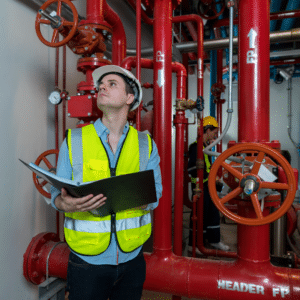Retro is on trend, but at DynaFire, having our Orlando fire suppression contractor retrofit older buildings with current Fire & Life Safety systems never went out of style.
If your commercial building is older, it’s likely time to evaluate its fire suppression system. Between normal wear and tear that comes with age and technological advances, upgrading your fire suppression system is an investment in the safety of your building and its occupants.
Building owners and property managers may be hesitant to retrofit their buildings because of the potential for a giant mess, inconvenient disruption to the building occupants, and cost. When you work with our Orlando fire suppression contractor, we can get your retrofit job done efficiently and professionally, ensuring minimal disruption to building occupants, a seamless retrofit process, and cost-effective solutions to meet your fire safety needs.
Retrofitting Is The Law
Another excellent reason to retrofit your building’s fire suppression system is that Florida law requires it. Certain retrofitting requirements were established to take effect on January 1, 2020, but were postponed because of COVID. The new deadline to retrofit high-rise buildings is January 1, 2024. And while the previous law allowed building owners to opt out of retrofitting, the new law does not.
How Does A Retrofit Work?
As you can imagine, retrofitting a building’s fire suppression system can be a significant undertaking, so it’s important to plan ahead so that you’re not subject to fines or loss of occupancy. At DynaFire, our Orlando fire suppression contractor can discuss every detail of this project with you, but here are the highlights of how a retrofit works.
- Find two contractors – one for your fire suppression system upgrade and one for construction.

- Ensure the Orlando fire suppression contractor you choose is fully licensed and certified to work on fire suppression systems (like us).
- Once permits have been issued, the construction contractor can open up the walls and ceilings, allowing our team to take over.
- We will inspect your current system and perform NFPA 13-compliant upgrades throughout your building (or in sections, such as one floor at a time).
- After our work is complete, a city inspector will approve all work done, then the walls and ceilings can be sealed.
- The new lines will be tied into the existing fire suppression system, and it will receive its final inspection.
- After the last connection is made, a Fire Watch is required because each floor’s fire suppression system needs to be turned off for 24 hours to allow plumbing glue to dry.
FAQs About Retrofitting Your Building
What Is An ELSS?
An Engineered Life Safety System (ELSS) is an alternative to a fire suppression system approved by NFPA 101. It uses a combination of detection equipment, smoke control measures, compartmentalization, and partial sprinkler coverage. While this system is technically okay, it will never provide the protection of a full fire suppression system.
What Can Happen If You Don’t Retrofit?
If you miss the January 1, 2024, deadline for retrofitting your high-rise building, you could be subject to fines and potentially lose your Certificate of Occupancy.
How Much Does A Retrofit Cost?
This is a tough question to answer without knowing the details of your building, including square footage, layout, and the condition or existence of the current fire suppression system. When we meet to discuss your project, we can give you a more accurate estimate based on your unique needs and situation. At DynaFire, we always work with your budget to give you the best options.
Let Our Orlando Fire Suppression Contractor Handle Your Retrofit
Keeping your building and its occupants safe is our number one priority. Doing it while keeping your business up to code and protected from fines and penalties is a huge bonus. Let us help you bring your Fire & Life Safety systems up to your required protection standards. Contact us today to get started.






